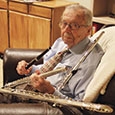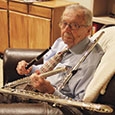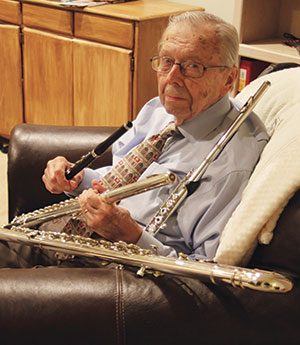
The recently released CD of the Einojuhani Rautavaara flute concerto, brilliantly performed by Sharon Bezaly and the Lahti Symphony (Bis), reminded me of my own programming strategies when I used to seek out pieces that required doubling on flute, piccolo, alto flute and bass flute. The Rautavaara concerto, for example, does exactly that by utilizing the flute in the first movement (but switching to bass flute in the middle section), piccolo in the second movement, alto flute in the third, flute and bass flute in the fourth. The bass flute ends the concerto forlornly with a sustained pianissimo high D natural against a B flat minor chord in the strings. Quite eerie! The concerto is published by Breitkopf & Härtel, Wiesbaden. On YouTube there is also a splendid recording by Jacques Zoon with the Netherlands Radio Philharmonic.
I had the honor of giving the first American performance of the Rautavaara concerto at the 1990 NFA convention in Minneapolis, conducted by Kurt Redel, and my debut NFA solo recital took place at the very first NFA convention in Anaheim in 1973, where I played a program that called for doubling between piccolo, flute and alto flute. Most of my recital programs since then have featured music for both flute and piccolo – and sometimes alto and bass flute.
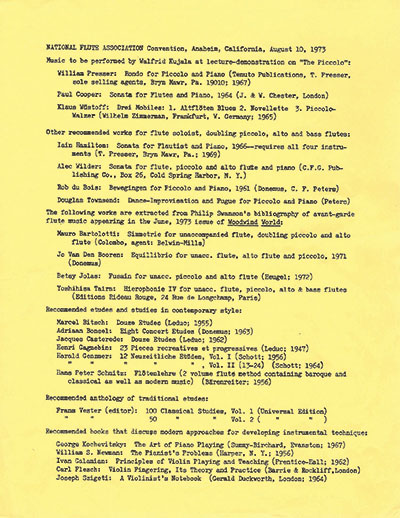
The handout for my 1973 lecture/performance.
Gunther Schuller’s flute concerto, which I premiered in 1988 with the Chicago Symphony under Sir Georg Solti, also calls for the soloist to alternate between flute and piccolo in the final movement. Schuller was very agreeable to my suggestion to include such a switch. (The concerto had been commissioned by my students and colleagues to honor my 60th birthday.)
Later, when I was invited to perform the Schuller concerto with the Rochester Philharmonic under guest conductor Robert Spano, I also added the Vivaldi C Major Piccolo Concerto (RV443) to the program. This was a pattern that I had previously adopted when soloing with other orchestras: programming one of the Vivaldi piccolo concertos followed by the Mozart D or G Major flute concertos, or the Ibert or Nielsen concertos.
If you are interested in performing pieces requiring flute doubling, I would like to recommend the following works:
Concerto for Flute (Piccolo) and Wind Ensemble or Orchestra, by Thom Ritter George. Published by Accura. There is a highly polished performance on YouTube by Phyllis Avidan Louke and the Oregon Symphonic Band conducted by Michael Burch-Pesses. There is also a recording on the album Ragtimes and Serenades by Mary Stolper and the DePaul Wind Ensemble conducted by Donald Deroche (Albany Records). (George has also composed another flute concerto with orchestra – this one without piccolo doubling – plus a flute and piano sonata.)
Drei Mobiles (Alto Flute Blues, Flute Novelette and Piccolo Waltz) by Klaus Wustoff. With piano, but also available with orchestral accompaniment, this work is published by Zimmerman and recorded by Leonard Garrison on Superflute (Capstone Records).
La Belle Époque, Concert Fantasy in the Form of a Quadrille, for piccolo doubling flute, and piano by Jacques Castérède. Published by Gérard Billaudot and recorded by Roberto Fabbriciani on Piccolo XX, this recording also features a large number of excellent piccolo solos (without flute doubling) by Janacek, Castiglioni, Donatoni, Ferneyhough, Loeb, Isang Yun, Togni, Stockhausen, and a Bucchi concerto.
Sonata No. 1 for flute, doubling alto flute & piccolo, and piano by Alec Wilder. This is published by Margun and recorded by Leonard Garrison on on Superflute (Capstone Records).
Sonata for flutes and piano, flute doubling piccolo and alto by Paul Cooper. This is published by J.W.Chester.
Terzinen, for flute doubling piccolo and alto flute by Tilo Medek. This is published by Veb Deutscher Verlag fur Music, Leipzig. I discovered Terzinen at a music store in East Berlin, Germany in 1978 and performed it as part of a joint recital with Samuel Baron at the 1979 NFA convention. It is a demanding but highly rewarding piece that is 18 minutes in length.
*Walfrid Kujala will be giving a lecture/demonstration on “Improving Your Phrasing Through Nuance Tapers” at the NFA convention in Minneapolis on August 13 at 9:30 AM.
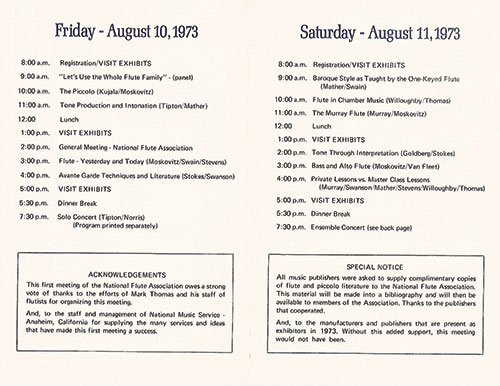
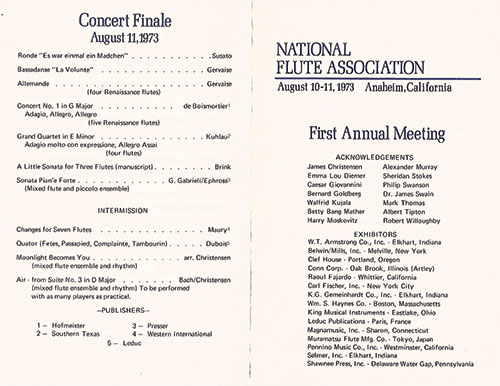
The program for that first convention (First Annual Meeting) was only four pages. Each event was labelled with the name of the presenter followed by the name of the person who was introducing the presenter. My introducer was Harry Moskovitz.
